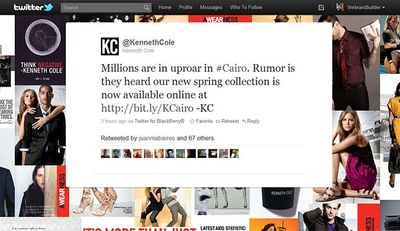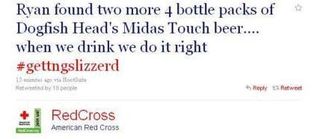
Scary Social Media Faux Pas – Don’t Be That Guy
Faux pas – the literal translation meaning “misstep,” inevitably results in the question, “What were they thinking?!” When someone performs a faux pas, all eyes are wide, ears are open, and that “misstep” can spread faster than you can say ‘wardrobe malfunction.’ And don’t be fooled into thinking that faux pas are just for fashion. Faux pas performed (by people, brands and/or businesses) on something like say, social media not only puts you and your company’s credibility on the line, but also your money. According to a survey by Symantec and Applied Research, the cost of public relations disasters, lawsuits, security breaches and other risks associated with social media blunders averages $4.3 million. The survey also reports that after a social media mishap, 28% of companies have reported damage to their brand, or a loss of customer trust averaging a cost of over $638,000. So to avoid putting our businesses and ourselves on the virtual chopping block, let’s get our social media etiquette on and learn from the missteps of others:
1. Don’t post something public, if it’s private
Showcasing your personality to your customers is important, but in the case of former Congressman Anthony Weiner, sharing a little too much, like your privates in this case, should be kept private. After Weiner tweeted a photo of his unmentionables to a woman in Seattle, he initially claimed his account had been hacked. After finally admitting the photo was self-sent, he resigned from the House of Representatives after 12 years in office. This case may be extreme, but the concept isn’t. Keep private information to yourself, this goes for your business and personal accounts. We want our friends and customers to be aware of what’s going on in our lives, but racy photos, updates about bodily fluids and/or ailments, cheating significant others, family legal battles, etc. need not be included.
2. Don’t pay for or create fake followers
Being honest and genuine is the name of game when it comes to social media. Faking the number of Twitter followers you have is a serious faux pas, just ask Newt Gingrich. With more than 1.3 million Twitter followers (more than any other GOP candidate), Gingrich seemed to be in the lead until word spread that most (92%) of those followers were fake and/or bought. If you try to fool others, you’ll only look like a fool. Think quality over quantity. Legitimately build your social media fan base by reaching out to your network. Tell people you’re on social media, ask them to find/like/follow you, (just don’t use ‘I’ll follow you back’ as an incentive) and make those pages easy to find.
3. Don’t lash out; do think twice before you post/tweet
If the name Boners BBQ doesn’t turn you off already, their very public Facebook lash out in response to a customer’s honest yelp review will. The small biz BBQ joint based in Atlanta obviously wasn’t pleased with a particular customer’s Yelp review, and instead of getting in touch, apologizing, or taking the feedback to heart, the restaurant posted the customer’s picture to their Facebook page, called her a *beep* and told her to *beep* off. Once other customers took concern to the restaurant’s unsavory behavior, the boys (and owner) at Boners told those customers to *beep* off too. A lash out like this could cause their ribs and reputation to both go up in smoke.
Charlie Sheen is another prime example of displaying erratic social media behavior. His incessant rants on Twitter included name-calling of former coworkers and the use of random hashtags such as #tigerblood. He also accidently tweeted his phone number to more than five million followers. Sheen may be a celebrity, but after his drama filled debacles, the thought of working with him would be anything but #winning.
4. Don’t use Twitter autoresponders
Social media should be just that, social. Nothing’s worse than following someone on Twitter, only to be immediately greeted by an obvious response generated from a non-personal Twitter bot: “Hey! Thanks for the follow! Like my company on Facebook too.” Not only do Twitter autoresponders come off as spammy, they’re impersonal and a quick fix. If you want your fans or customers to know you care, connect with them personally, don’t let a bot do the talking for you.
5. Don’t mix up your personal and business accounts

Using social media tools like Roost or Hootsuite are excellent ways to organize and post to multiple social media accounts using just one interface. However, make sure your personal account isn’t one of them. Accidently posting something you intend for your personal account to a business profile can cause some serious embarrassment. Red Cross learned this lesson when an employee accidently posted to the @RedCross Twitter account that she was drinking beer and #gettngslizzerd at work. Red Cross, however, responded in good nature: “We’ve deleted the tweet but rest assured the Red Cross is sober and we’ve confiscated the keys.” In response, Red Cross received several donations AND beer koozies for handling the mishap so well.
6. Don’t piggyback on trending topics
Trending topics on Twitter are a great way to join in on a mass discussion, however, abusing those topics in a distasteful or unrelated way for the exposure could land you in a PR nightmare just like Kenneth Cole. During the riots in Egypt, the Kenneth Cole founder sent an offensive tweet relating their new spring collection to the uproar in Cairo. The distasteful tweet caused a viral uproar on the Internet resulting in #boycottKennethCole hash tags – Not the kind of exposure I’m sure they were hoping for.

7. Don’t send all of your posts at once and/or sound like a broken record
Blasting your customers with a multitude of posts not only hijacks someone’s screen, but also screams, “look at me!” In, return your fans will just “delete, delete, delete.” Using a social media tool/platform (like Roost) allows you to time your posts so that you can enter several at once, but release them in a spread-out and timely manner.
Also, share unique information on each of your social media channels. If you’re posting the same information on each channel, your followers won’t have enough incentive to follow or like you in multiple places. Offer discounts just to Twitter fans, share fun photos on Pinterest, or place a poll on Facebook. Mix things up to avoid the broken record syndrome.
8. Don’t forget to use social sharing buttons
According to research by BrightEdge Technologies, websites donning social sharing buttons received 7xs more mentions/shares as a result. You have fabulous content, make sure people can share it to their social media accounts. Sharing content has somewhat replaced engagement such as leaving comments (on a blog for instance), so let them and don’t prevent them! On every blog post, email, newsletter, etc. that you create, enable social sharing buttons, and test them to make sure they work.
9. Don’t launch a campaign without a little research
Here’s food for thought: Find out what people are saying about you/your company (and in McDonald’s case, your food) before you launch a testimonial social media campaign. As Forbes put it, McDonald’s latest Twitter campaign fail went from hashtag to “bashtag.” McDonald’s promoted the hashtag #McDStories on Twitter in hopes that it would inspire customers to tweet about their favorite Happy Meal memories. Instead, people weren’t lovin’ it and the campaign created an eruption of graphic, gross and/or cheeky responses, including “One time I walked into McDonalds and I could smell Type 2 diabetes floating in the air and I threw up. #McDStories.”
Now that we’ve divulged in the social media blunders of others, are there any other faux pas you wish others wouldn’t commit? Put your social media faux pas police cap on and spill all!
© 2012 – 2018, Contributing Author. All rights reserved.




